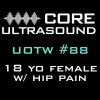A 19-year-old female presented to the emergency department with acute right ankle pain and inability to bear weight after falling while dancing in high heel shoes. She was otherwise healthy, with no pertinent past medical history. She endorsed pain primarily along the posterior aspect of her right ankle and lower calf. Physical exam of the right ankle was notable for no bony deformity, tenderness along the posterior ankle and distal calf, inability to actively plantarflex the right foot.
Given the patient’s presenting complaints and constellation of physical exam findings, the emergency physician performed a bedside ultrasound, confirming the suspected diagnosis. The first clip below is the normal side, the second clip is the affected side.

Answer and Pearl: Achilles tendon rupture, complete
- Using the high frequency, linear probe and the patient prone, place the probe just above the calcaneous in the longitudinal orientation.
- The Achilles tendon should be uniform in thickness and echogenicity in a longitudinal plane, and has a predominately flat or concave anterior margin in a transverse plane.1
- Dynamic imaging is important in evaluation of Achilles tendon tears since hemorrhage, fluid, debris, or scar tissue may fill the gap between torn tendon ends. With passive movement of the foot or by gently squeezing the calf muscles (Thompson test), the gap between the torn tendon ends becomes more obvious as one tendon end moves without translation of movement to the other tendon end.1
- Achilles tendon enlargement greater than 1 cm in the anterior–posterior dimension or marked intrinsic tendon abnormalities, such as a hypoechoic or anechoic cleft, indicates a partial tear.1
- A full-thickness tear is characterized by complete tendon fiber disruption and tendon retraction.1
- PRO-TIP: start with the unaffected side. Get a sense of the patient’s normal anatomy. Then continue to the affected side. You are looking for evidence of hypoechoic edema or interruption to the organized Achilles tendon appearance on ultrasound.
- On the unaffected the Achilles tendon in the near field of the image has an uninterrupted, linear, and organized appearance. This is the appearance of normal tendon. On the affected side, there is no linear, normal alignment of tendon visualized. A complete tendon rupture typically demonstrates sections of linear tendon alignment, flanking an area of heterogenous, nonlinear tendon and a hypo-echoic area of fluid.
- Most pathology, including tears and tendonopathy occur approximately 2–6 cm from the Achilles insertion.2
- This patient had surgical repair of her complete Achilles tendon rupture 8 days after her initial injury with a popliteal block and general anesthesia.
As with all of the cases I’ll share: A big THANK YOU out to the MGH residents and PAs for obtaining these images and sharing the case, specifically Dr. Andrew Goldsmith in this case. Even more gratitude to the MGH US Division for being openly supportive of ultrasound education and selflessly spreading the ultrasound love!




